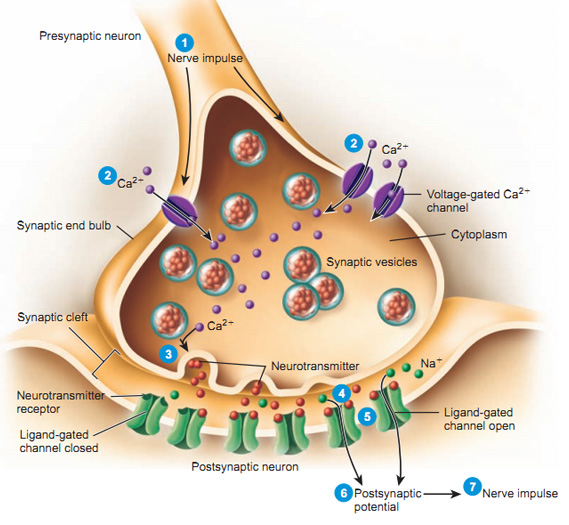Synaptic transmission: Difference between revisions
added more information on the formation of graded potentials, added spaces between words where there wasn't any |
Added potassium ions movement out of postsynaptic cell, corrected grammar and rearranged some sentences (e.g. made neurotransmitter non-specific) to aid understanding. |
||
| Line 1: | Line 1: | ||
[[Image:Synapse.jpg|right|Synapse.jpg]] | [[Image:Synapse.jpg|right|Synapse.jpg]] Synaptic transmission occurs when an [[Action potential|action potential reaches]] an [[Axon|axon]] terminal, depolarising the [[Pre synaptic membrane|presynaptic membrane]]. Voltage gated Ca<sup>2+</sup> channels in the [[Presynaptic membrane|presynaptic membrane]] open in response to the [[Depolarisation|depolarisation]]<ref>Antranik (2012) Synaptic Transmission by Somatic Motorneurons, [Online], Available: http://antranik.org/synaptic-transmission-by-somatic-motorneurons/ accessed [27 Nov 2013].</ref>, allowing Ca<sup>2+ </sup>ions to<sup> </sup>enter the axon terminal down their [[Concentration Gradient|concentration gradient]]. This causes [[Vesicles|vesicles]] containing neurotransmitter molecules (e.g.[[Acetylcholine|Acetylcholine]] molecules) to migrate towards the [[Presynaptic membrane|presynaptic membrane]], and then <span style="font-size: 13.28px;">fuse with the </span>[[Presynaptic membrane|presynaptic membrane]]<span style="font-size: 13.28px;">, </span><span style="font-size: 13.28px;">releasing neurotransmitter molecules into the </span>[[Synaptic cleft|synaptic cleft]]<span style="font-size: 13.28px;"> by the process of </span>[[Exocytosis|exocytosis]]<span style="font-size: 13.28px;">. The molecules of neurotransmitter </span><span style="font-size: 13.28px;">diffuse across the </span>[[Synaptic cleft|synaptic cleft]]<span style="font-size: 13.28px;"> and bind to their receptors on the </span>[[Postsynaptic membrane|postsynaptic membrane]]<span style="font-size: 13.28px;">. The binding of neurotransmitter molecules </span><span style="font-size: 13.28px;">causes ligand-gated Na</span><sup>+</sup><span style="font-size: 13.28px;"> channels in the [[Postsynaptic membrane|postsynaptic membrane]] to open. Na</span><sup>+</sup><span style="font-size: 13.28px;"> ions subsequetly rush into the </span>[[Postsynaptic cell|postsynaptic cell]], and because these channels are non-specifc, K<sup>+ </sup>ions can also leave the postsynpatic cell down their concentration gradient. This particular movement of ions <span style="font-size: 13.28px;">generates a [[Graded potential|g]]</span><span style="background-color: white; font-size: 13.28px;">[[Graded potential|raded_potential]]</span><span style="font-size: 13.28px;"> in the postsynaptic membrane. If that [[Graded potential|g]]</span><span style="background-color: white; font-size: 13.28px;">[[Graded potential|raded potential]]</span><span style="font-size: 13.28px;">[[Graded potential| is]] [[Suprathreshold|suprathreshold when]] it arrives at the </span>[[Axon hillock|axon hillock]]<span style="font-size: 13.28px;"> then an </span>[[Action potential|action potential]]<span style="font-size: 13.28px;"> will fire in the </span>[[Postsynaptic neurone|postsynaptic neurone]]<span style="font-size: 13.28px;">, if the </span>[[Graded potential|graded potential]]<span style="font-size: 13.28px;"> is </span>[[Subthreshold|subthreshold]]<span style="font-size: 13.28px;"> when it arrives at the </span>[[Axon hillock|axon hillock]]<span style="font-size: 13.28px;"> then an </span>[[Action potential|action potential]]<span style="font-size: 13.28px;"> will not fire in the </span>[[Postsynaptic neurone|postsynaptic neurone]]<span style="font-size: 13.28px;">.</span> | ||
=== References === | === References === | ||
<references /> | <references /> | ||
Revision as of 10:41, 21 November 2017

Synaptic transmission occurs when an action potential reaches an axon terminal, depolarising the presynaptic membrane. Voltage gated Ca2+ channels in the presynaptic membrane open in response to the depolarisation[1], allowing Ca2+ ions to enter the axon terminal down their concentration gradient. This causes vesicles containing neurotransmitter molecules (e.g.Acetylcholine molecules) to migrate towards the presynaptic membrane, and then fuse with the presynaptic membrane, releasing neurotransmitter molecules into the synaptic cleft by the process of exocytosis. The molecules of neurotransmitter diffuse across the synaptic cleft and bind to their receptors on the postsynaptic membrane. The binding of neurotransmitter molecules causes ligand-gated Na+ channels in the postsynaptic membrane to open. Na+ ions subsequetly rush into the postsynaptic cell, and because these channels are non-specifc, K+ ions can also leave the postsynpatic cell down their concentration gradient. This particular movement of ions generates a graded_potential in the postsynaptic membrane. If that graded potential is suprathreshold when it arrives at the axon hillock then an action potential will fire in the postsynaptic neurone, if the graded potential is subthreshold when it arrives at the axon hillock then an action potential will not fire in the postsynaptic neurone.
References
- ↑ Antranik (2012) Synaptic Transmission by Somatic Motorneurons, [Online], Available: http://antranik.org/synaptic-transmission-by-somatic-motorneurons/ accessed [27 Nov 2013].